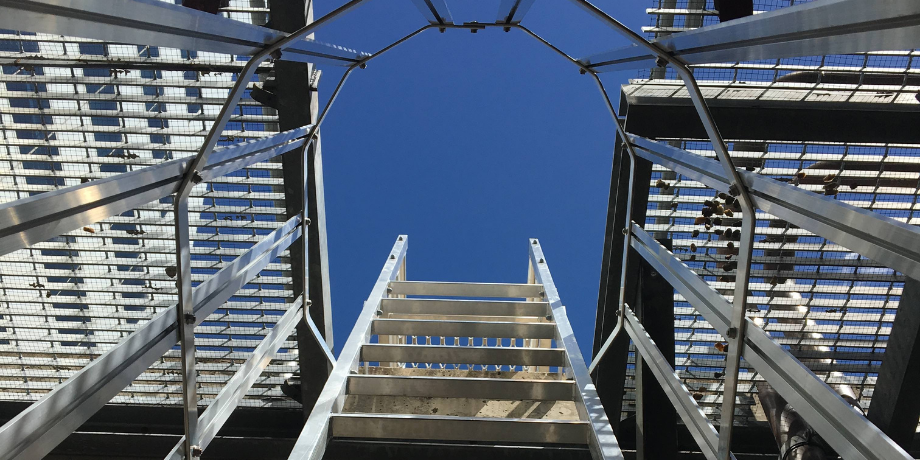
A Hierarchy of Control system can help you eliminate hazards and minimise risks before you even begin work. And that’s always the best time to do it!
That’s why we always use a best practice Hierarchy of Control System. On every site, every project, every job.
It helps us to focus on fall prevention, not just fall protection. And to apply life-saving control measures earlier, rather than later. In order to progressively reduce risk and maximise height safety.
Want to level-up your height safety? Use our Hierarchy of Control system today.
Hierarchy of Control – Four-Tier System
The four-tier Hierarchy of Control system we use has been adapted from industry best practice.
Working top-to-bottom, it’s designed to eliminate, reduce, control and finally mitigate work-at-height risks:
- Hazard Elimination
- Risk Reduction (Substitution, Isolation, Engineering Controls)
- Administrative Controls
- Personal Protective Equipment
Let’s work through each level step-by-step.
- HAZARD ELIMINATION
Let’s start with the highest level in our Hierarchy of Control – and your first line of defence. That is to either avoid working at height or to eliminate hazards altogether. This is the most universal and effective way to manage risk.
| Elimination examples: |
|---|
| Relocating plant to ground level for risk-free maintenance (eg HVAC) |
| Cleaning windows from ground level using extension (vs using ladder) |
| Avoiding noxious fumes by removing toxic chemicals from confined space |
| Preventing falls by removing trip hazards from around the worksite |
Every hazard you can eliminate leaves you with less to worry about on the job. Less to work around, less to control for, less to protect yourself from. Which will make doing your job faster, easier and often cheaper.
So start here and exhaust your elimination opportunities before your feet even leave the ground.
- RISK REDUCTION
For remaining unavoidable hazards, employ our three risk reduction strategies – substitution, isolation and the use of engineering controls.
Working methodically through each will help identify more ways to make your site safer. As with elimination, the focus here is on fall prevention (vs fall protection which comes later).
SUBSTITUTION
Can you reduce risk by substituting the hazard with a safer alternative?
| Substitution examples: |
|---|
| Using water-based paint (vs solvent-based paint) in confined spaces |
| Replacing a portable ladder with a fixed ladder plus cage for extra safety |
| Using an enclosed, elevated work platform (vs open ladder system) |
ISOLATION
Can you reduce risk by isolating the hazard? Or by isolating yourself from the hazard?
| Isolation examples: |
|---|
| Isolating hazardous substances on-site away from work areas |
| Relocating dangerous equipment to locked areas or safety cabinets |
| Working in fall restraint (vs fall arrest) to keep away from fall hazards |
| Enabling remote operation of dangerous machinery |
ENGINEERING CONTROLS
Can you engineer a physical barrier or mechanical control to reduce risk?
| Engineering Control examples: |
|---|
| Erecting guardrails or a solid wall between you and the hazard |
| Installing additional ventilation to filter any fumes in confined spaces |
| Applying sound dampening materials on-site to reduce noise pollution |
- ADMINISTRATIVE CONTROLS
Administrative controls are a less direct, more passive form of risk reduction. Like speed-bumps on a road, they force us to slow down. And that bit of extra time to think about what we’re doing can be a life-saver.
| Administrative Control examples: |
|---|
| Signage at entry point detailing on-site safety requirements |
| Requirement for a permit (or other approvals) prior to commencing work |
| Work Method Statement establishing standards, methodology, process |
- PERSONAL PROTECTIVE EQUIPMENT (PPE)
Finally, let’s move our focus on from fall prevention to fall protection.
PPE is what you wear to stay connected to the height safety system and/or structure you’re working on. PPE is also your last line of defence in the event of a fall. Its job is to arrest your fall and to minimise the impact on you.
This is why choosing the right PPE is the last but critical step in reducing risk:
| PPE examples: |
|---|
| A full-body, full-featured, fall arrest harness |
| A fall arrest lanyard with built-in energy absorber |
| A suitably strong connector and secure anchorage |
| A height-safe helmet with protection from top and side impacts |
| A height-safe helmet with a chin-strap to keep helmet on during fall |
| Eye protection, protective gloves, suitable footwear |
Hierarchy of Control – New Case Study
From PPE to Rooftop Walkway
See how we used our Hierarchy of Control to design a better, safer, more sustainable rooftop maintenance solution.



